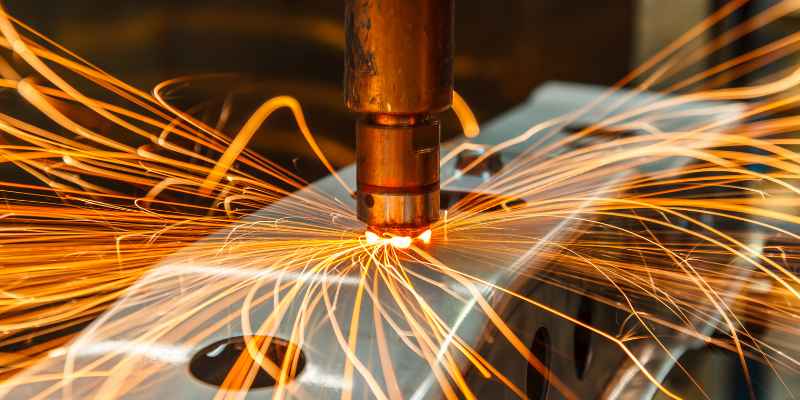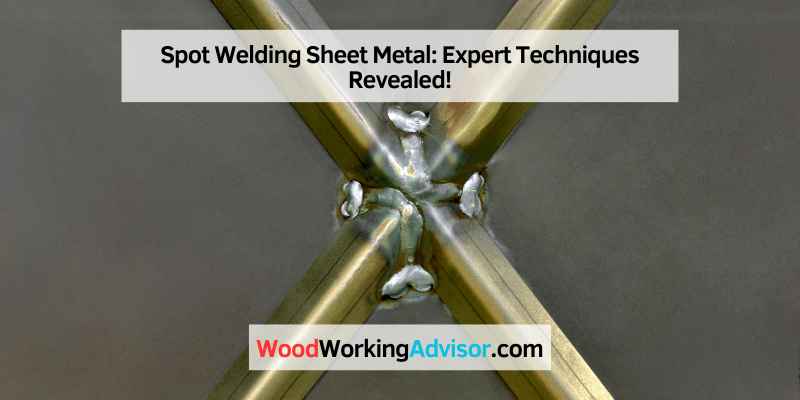Spot welding is a commonly used process for joining sheet metal by creating a series of small, localized welds. It is a fast and efficient method that produces strong and reliable welds.
Sheet metal, often used in automotive and manufacturing industries, can be easily spot welded using this technique.
Basics Of Spot Welding
Spot welding sheet metal is a common method of joining two metal sheets together quickly and efficiently.
Definition And Process Overview
Spot welding is a process where two pieces of metal are joined together by applying heat and pressure to a small area, forming a weld bond.
Materials And Equipment Needed
- Metal Sheets: The pieces of metal you want to join together
- Spot Welding Gun: Used to deliver the current to the metal sheets
- Electrodes: Copper alloy tips that conduct the electric current
- Power Source: Provides the necessary electrical energy for the process

Advanced Spot Welding Techniques
Spot welding is a highly effective method for joining sheet metal, offering strength and durability. However, advanced spot welding techniques have emerged to address specific challenges and enhance the welding process. These techniques include pulse welding for thin sheets and the application of robotic spot welding. By understanding and implementing these techniques, manufacturers can achieve superior weld quality and efficiency.
Pulse Welding For Thin Sheets
Pulse welding is a specialized technique tailored for thin sheets, typically ranging from 0.5mm to 1.5mm in thickness. When welding these thin sheets with conventional spot welding, excessive heat can cause distortion and damage to the metal. However, pulse welding overcomes this issue by using a modified current waveform that produces shorter, controlled pulses of electrical energy.
- Reduces heat input and minimizes the risk of metal distortion.
- Enhances control over the welding process and improves weld quality.
- Increases productivity by allowing for faster welding speeds.
Robotic Spot Welding Applications
Robotic spot welding has revolutionized the sheet metal fabrication industry by offering precise and efficient welding capabilities. This technique involves the use of automated robotic arms equipped with spot welding guns to perform welds with exceptional accuracy and consistency.
| Benefits of Robotic Spot Welding: |
|---|
| 1. Increased productivity due to faster welding speeds and reduced cycle times. |
| 2. Improved weld quality, as robots consistently apply the correct amount of force and maintain precise weld parameters. |
| 3. Enhanced worker safety by minimizing their exposure to hazardous welding environments. |
Factors Influencing Weld Quality
The quality of spot welds in sheet metal fabrication is influenced by several key factors. Effective spot welding relies on the precise management of temperature, pressure, and duration. By understanding these critical elements, manufacturers can ensure consistent and reliable weld quality.
Temperature Control
Maintaining optimal temperature is crucial for achieving high-quality spot welds. The heat input should be carefully regulated to prevent excessive material distortion while still achieving proper fusion. Adequate temperature control minimizes the risk of overheating, which can lead to weak welds and structural integrity issues.
Pressure And Duration
Controlling the applied pressure and duration of the welding process plays a significant role in weld quality. Applying the correct amount of force ensures proper material bonding, while adjusting the duration of the weld cycle can impact the overall strength and resistance of the joint. The combination of pressure and duration directly influences the cross-sectional area of the weld nugget, an essential factor in achieving reliable welds.
Troubleshooting Common Welding Issues
When spot welding sheet metal, it’s essential to troubleshoot common welding issues that can arise during the process. Identifying and resolving these issues promptly can ensure high-quality welds and efficiency. Let’s delve into some of the common problems encountered during spot welding, along with effective troubleshooting techniques.
Burn-through Problems
One prevalent issue when spot welding sheet metal is burn-through, where the weld burns completely through the material, resulting in a hole. To troubleshoot burn-through problems, it’s crucial to consider adjusting the welding parameters, such as reducing the current or increasing the welding time. Another effective approach is to use a copper backing plate to dissipate heat and prevent burn-through. Additionally, ensuring that the metal surfaces are clean and properly aligned can mitigate burn-through issues.
Weak Weld Joints
Weak weld joints can compromise the integrity of the spot-welded sheet metal, leading to structural concerns. Addressing weak weld joints involves troubleshooting the welding pressure and ensuring that it is sufficient to create a strong bond between the sheets. Verifying the electrode tip condition and alignment is crucial, as worn or misaligned tips can result in weak welds. Furthermore, optimizing the welding parameters for the specific sheet metal thickness can significantly enhance the strength of the weld joints.
Best Practices For Spot Welding
When spot welding sheet metal, it’s crucial to follow best practices to ensure optimal results. Properly preparing the metal surfaces, determining the correct welding parameters, and ensuring proper electrode pressure are essential steps. Additionally, maintaining consistent welding procedures and inspecting the welds for quality are important to achieve strong and durable spot welds.
When it comes to spot welding sheet metal, following best practices is essential to achieve strong and reliable welds. Spot welding is a popular method used in the automotive and manufacturing industries for joining metal sheets together. Proper electrode maintenance and optimizing welding parameters are two crucial aspects that can greatly impact the quality and efficiency of spot welding.
Proper Electrode Maintenance
Maintaining the electrodes in good condition is key to achieving consistent and quality spot welds. Electrodes can wear out over time due to the high temperatures and pressures involved in the welding process. Here are some best practices for electrode maintenance:”
- Regularly inspect and clean the electrodes to remove any debris or contaminants that can hinder proper contact between the electrode and the metal sheets.
- Monitor the electrode tip shape and ensure it remains in good condition. A worn-out or deformed tip can lead to uneven or weak welds.
- Replace the electrodes if they show signs of damage or excessive wear to maintain optimal performance.
- Use electrode dressers or reconditioning tools to restore the electrode’s shape and extend its lifespan.
Optimizing Welding Parameters
Optimizing the welding parameters is crucial for achieving optimal spot weld results. The welding parameters include factors such as current, welding time, electrode force, and electrode alignment. Consider these best practices when adjusting the welding parameters:”
- Start by setting the appropriate current level based on the material thickness and type. Too low or too high current can result in weak welds or damage to the material.
- Ensure the welding time is sufficient for the weld nugget to form properly. However, excessive welding time can lead to overheating and potential damage to the surrounding material.
- Proper electrode force is crucial for achieving a strong weld. Too little force can result in insufficient contact and weak welds, while excessive force can damage the metal sheets.
- Align the electrodes accurately to ensure uniform heat distribution and consistent weld quality across the joint.
Future Trends In Spot Welding
Spot welding of sheet metal is evolving rapidly, embracing innovative technologies to enhance efficiency and quality.
Automation And Industry 4.0 Integration
Automation and Industry 4.0 Integration are reshaping the spot welding landscape, streamlining processes and driving productivity.
Advancements In Weld Inspection Technology
Advancements in Weld Inspection Technology are revolutionizing quality control, ensuring precise and reliable results.
Spot Welding Vs. Other Joining Techniques
When choosing a method to join sheet metal, spot welding stands out as a popular choice. Let’s delve into Spot Welding vs. Other Joining Techniques.
Comparison With Mig And Tig Welding
MIG and TIG welding use filler materials while spot welding joins metal sheets by applying heat and pressure in localized spots.
Strengths And Limitations
- Strengths:
- Fast and efficient method
- Robust welds due to concentrated heat
- Ideal for high-volume production
- Limitations:
- Not suitable for thick metals
- Requires precise alignment of metal sheets
- May cause warping of thin sheets
Frequently Asked Questions On Spot Welding Sheet Metal
What Is Spot Welding And How Does It Work?
Spot welding is a process of joining two metal sheets together by applying heat and pressure to a small area. An electric current is passed through the metal sheets, causing them to melt and form a bond. This method is commonly used in the automotive and manufacturing industries for its speed and efficiency.
What Are The Advantages Of Spot Welding For Sheet Metal?
Spot welding offers several advantages for sheet metal, including fast assembly, high structural integrity, and minimal damage to the metal surface. It also provides a clean and consistent weld, making it ideal for mass production and automated manufacturing processes.
What Types Of Sheet Metal Are Suitable For Spot Welding?
Various types of sheet metals can be spot welded, including steel, stainless steel, aluminum, and copper. Each metal has specific welding requirements, such as the proper welding current and electrode materials, to ensure strong and durable welds.
Can Spot Welding Be Done On Thin Sheet Metal?
Yes, spot welding is commonly used for thin sheet metal, as it allows for precise control of the welding process. By adjusting the welding parameters, such as current and duration, thin sheet metals can be spot welded without causing deformation or burn-through.
Conclusion
To wrap it up, spot welding is a highly efficient method for joining sheet metal. With its speed, precision, and cost-effectiveness, it has become an indispensable process in various industries. Whether you’re working with automotive parts or creating intricate designs, spot welding provides the strength and durability needed for your projects.
By understanding the basics and following proper techniques, you can confidently utilize spot welding to achieve reliable and long-lasting results. So, don’t hesitate to explore the possibilities of spot welding in your metalworking endeavors.


